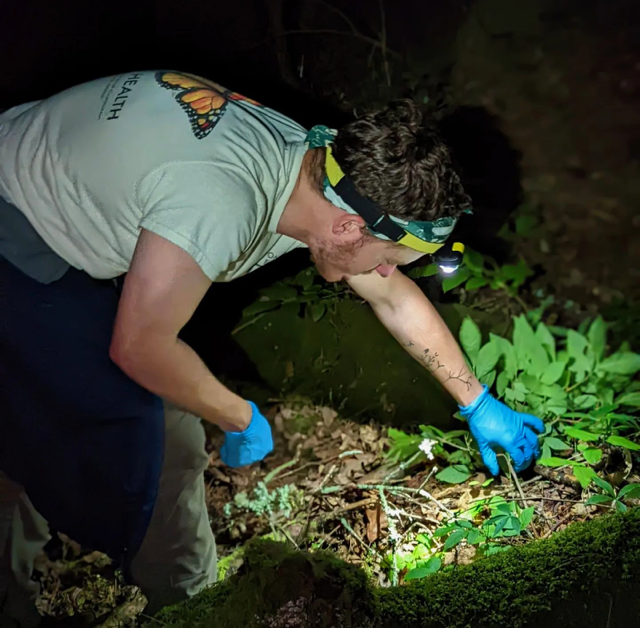Meet the Editors: Q&A with TJ Odom, Social Media Editor for Parasitology.
Welcome to our “Meet the Editors” series, where we interview the editorial team about their work and their relationship to the journal. In this post we meet TJ Odom, Social Media Editor for Parasitology.

What is your current job title both within Parasitology and outside the journal? Where are you based in the world?
I serve as a Social Media Editor for Parasitology, working closely alongside my fellow social media conspirator Emily Pascoe to manage the social media accounts associated with the journal as well as organizing blog posts published on the Cambridge Core Blog site. Home is Atlanta, Georgia, USA. I’m currently a PhD candidate in Ecology at the Odum School of Ecology at The University of Georgia. My dissertation work seeks to tease apart mechanisms of parasite mediated competition in amphibian communities and their influence on the spatial distribution of host species in montane systems. I also serve as the chair of the Disease Mapping Working Group at the Center for the Ecology of Infectious Diseases (CEID) housed at The University of Georgia.

In a few sentences, please describe the focus of your work. Which parasites do you study? What is the goal of your research? What approaches do you use in your work?
Competitive interactions between host species can determine where they occur on the landscape, with some species excluding others from access to limited resources such as suitable habitats or prey communities. Several mechanisms have been identified as drivers of competition, but the degree to which parasite communities shape the spatiotemporal distribution of host species remains an outstanding question in disease ecology. I’m particularly interested in the competitive dynamics between host species that share helminth parasites but experience asymmetrical costs of infection. These questions have led me down on a beautiful journey lined with opportunities to conduct field work collecting salamanders across the Southern Appalachian Mountain Range, hone my classical parasitology skills to characterize their parasitic helminth communities, and leverage tools like modeling and machine learning to identify host, parasite, and environmental traits shaping the distribution and abundance of disease.
When did you first become interested in parasitology as a field? Did a particular teacher or mentor direct your career path?
My early research interests fell within the realm of the study of the human microbiome. I applied to graduate programs with faculty doing microbiome research and found who would eventually become the mentor for my MS in Biology, Dr. Stephen Greiman at Georgia Southern University, USA. He was studying microbiome-helminth interactions in shrews, and a large portion of that work involved parasite morphology. After realizing the extent of the diversity and abundance of parasitic worms in both humans and wildlife, I quickly switched teams and have been dancing to the parasitology drum ever since.
How did you first become familiar with Parasitology?
I’ve encountered studies published in Parasitology throughout my graduate studies, with the journal aiding me tremendously in keeping up with the cutting edge of our discipline.
What motivated you to become a social media editor at Parasitology?
I have a heart for scicomm, and I am excited at the opportunity to collaborate with an international team of editors to produce a journal that reaches such a diverse, interdisciplinary, creative, and collaborative community. On a more serious note, the mistrust and growing disconnect between academic, government, and industry science and the populations we are meant to serve, particularly evident during the SARS-CoV-2 pandemic, further emphasize the critical role of good science communication in fostering trust between researchers and members of the broader community.
What is the best part of working with Parasitology?
The best part of working with Parasitology is certainly the editorial team that I get to work with, each providing a unique perspective. I love the creative energy and dedication to making Parasitology the best journal it can be.

What advice would you give to those new to social media? How can they successfully interact with social media to broaden their scientific outreach?
My advice for those new to social media, particularly platforms such as X (formerly Twitter), Facebook, and Bluesky would be to follow what/ who you’re interested in and repost/ produce content reflective of that. Social media can be such a powerful tool when wielded intentionally and tactfully. Is someone doing research that excites you? Follow them. Interact with their posts. I’ve seen networking and collaboration play out on X that could never happen organically on platforms more geared toward professional interactions like LinkedIn.
What advice would you give to early career researchers who are just starting out in parasitology as a field?
I think one of the most powerful moves an early career researcher in parasitology can make is diversifying your toolkit. The discipline of parasitology is evolving, for the better I think, toward a more holistic approach to investigating the eco-evolutionary processes that shape the diversity and distribution of parasites on earth. Classical parasitological tools like morphology and microscopy are now bolstered with more modern approaches like genome sequencing, bioinformatics, as well as ecological and mathematical modeling to investigate mechanisms shaping parasite dynamics across biological and ecological scales.






